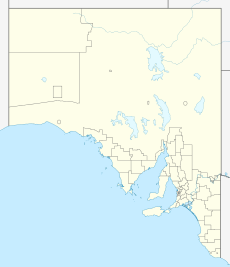Myponga Conservation Park facts for kids
Quick facts for kids Myponga Conservation ParkMyponga, South Australia |
|
|---|---|
|
IUCN Category III (Natural Monument)
|
|
| Nearest town or city | Myponga |
| Established | 24 February 1972 |
| Area | 1.67 km2 (0.6 sq mi) |
| Managing authorities | Department for Environment and Water |
| See also | Protected areas of South Australia |
Myponga Conservation Park is a special protected area in South Australia. It's located in a place called Myponga. This park is about 59 kilometers (37 miles) south of Adelaide, the state's capital city. It's also about 5 kilometers (3 miles) south-south-west of the town of Myponga itself.
About Myponga Conservation Park
Myponga Conservation Park is a natural space that helps protect local plants and animals. It was first set up as a protected area on February 24, 1972. Back then, it was called the Myponga National Park.
Just a few months later, on April 27, 1972, its name changed. It became the Myponga Conservation Park. This change happened under a new law called the National Parks and Wildlife Act 1972. As of 2018, the park covers an area of 1.67 square kilometers (0.64 square miles).
Exploring the Park
The park is a great place for walking and enjoying nature. The famous Heysen Trail passes through it. This is a very long walking trail that stretches across South Australia. In Myponga Conservation Park, the Heysen Trail enters from the south and goes along the western side of the park.
Plants and Animals
Myponga Conservation Park is home to many different kinds of plants and animals. It has a rich variety of plant life, which helps support the animals living there. Many of these animals are typical of the Fleurieu Peninsula area.
Special Wildlife
One important animal found here is the Southern brown bandicoot (Isoodon obesulus). This small marsupial is considered locally endangered. This means it's at risk of disappearing from the local area.
Unique Plants
The park also protects some rare plants. These include Casuarina striata and Cheiranthera cyanea. These plants are not commonly found elsewhere.
Types of Plant Life
The park's landscape is hilly, which is common for the Fleurieu Peninsula. You can find three main types of plant areas:
- Low Open Forest: In areas with better soil, especially near creeks and along ridges, you'll find a low open forest. Here, the main trees are Eucalyptus leucoxylon and Eucalyptus obliqua.
- Open Scrub: On the hill slopes, there's an open scrub. This area has Eucalyptus cosmophylla, along with some smaller Eucalyptus fasciculosa and Eucalyptus leucoxylon. Underneath these trees, there's a thick layer of shrubs like Hakea, Banksia, and Xanthorrhoea (also known as grass trees).
- Closed Heath: Some parts of the hill slopes also have patches of closed heath. These areas are dense with the same types of shrubs mentioned above.
Myponga Conservation Park is mostly untouched by human development. This makes it a very important natural space, even though it's surrounded by farms and towns.
Park Protection Status
The park is officially recognized as an IUCN Category III protected area. This means it's protected mainly for its natural features. In 1980, it was also listed on the Register of the National Estate. This register used to list important natural and cultural places in Australia, but it no longer exists.


